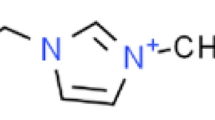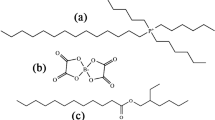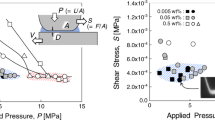Abstract
WHEN surfaces in relative motion are separated by a fluid layer of appreciable thickness, the resistance to motion is due to the viscosity of the interposed layer. This type of lubrication is essentially a problem in hydrodynamics; the friction is very small and there is no wear of the moving surfaces. It is clear, however, that in many practical cases fluid lubrication is impossible. In many sliding mechanisms, or at the beginning and end of a reciprocating stroke, it is difficult for a thick continuous film of lubricant to be maintained, and even in rotating parts the thick film may break down and only a thin film of lubricant may remain. In such cases the friction is influenced by the nature of the underlying surfaces as well as the chemical constitution of the lubricant, and Hardy referred to such a state as ‘boundary lubrication’. Boundary lubrication is of great importance in practice, and the nature of the surface film will determine whether serious wear or seizure will take place. The coefficient of friction for really clean metals which have been out-gassed in a good vacuum is high and may be1 about μ = 6. For ordinary unlubricated metal surfaces which are exposed to the air the coefficient of friction is of the order of μ = 0·5–1. For metal surfaces lubricated with a boundary film μ is about 0·05–0·15. This is considerably less than for clean surfaces, but is much higher than for fluid lubrication.
This is a preview of subscription content, access via your institution
Access options
Subscribe to this journal
Receive 51 print issues and online access
$199.00 per year
only $3.90 per issue
Buy this article
- Purchase on Springer Link
- Instant access to full article PDF
Prices may be subject to local taxes which are calculated during checkout
Similar content being viewed by others
References
Bowden and Hughes, Proc. Roy. Soc., A, 160, 575 (1937).
Hardy, "Collected Works" (Camb. Univ. Press, 1936).
Sameshima et al., Bull. Chem. Soc. Japan, 11, 659 (1936).
Beare and Bowden, Phil. Trans., A, 234, 329 (1935).
Bowden and Leben, Proc. Roy. Soc., A, 169, 371 (1939).
Langmuir, J. Franklin Inst., 218, 143 (1934).
Bowden and Leben, Phil. Trans., A, 239, 1 (1940).
Hughes and Whittingham, Trans. Farad. Soc., 38, 9 (1942).
Frewing, Proc. Roy. Soc., A, 181, 23 (1942).
Isemura, Bull. Chem. Soc., Japan, 15, 467 (1940).
Bowden, Leben and Tabor, Trans. Farad. Soc., 35, 900 (1939).
Tabor, Nature, 145, 308 (1940); 147, 609 (1941).
Dubrisay, C.R. Acad. Sci., 210, 533 (1940).
Lawrence, Trans. Farad. Soc., 34, 1 (1938).
Tanaka, Mem. Coll. Science, Kyoto Univ., 21, 85 (1938); 22, 377 (1939).
Beeck, Givens and Smith, Proc Roy. Soc., A, 177, 90 (1940).
Bowden, Moore and Tabor, J. Appl. Phys., 14, 80 (1943).
Sakmann, Burwell and Irvine, J. Appl. Phys., 15, 459 (1944).
Bowden and Moore, Nature, 155, 451 (1945).
Author information
Authors and Affiliations
Rights and permissions
About this article
Cite this article
BOWDEN, F., GREGORY, J. & TABOR, D. Lubrication of Metal Surfaces by Fatty Acids. Nature 156, 97–101 (1945). https://doi.org/10.1038/156097a0
Issue Date:
DOI: https://doi.org/10.1038/156097a0
This article is cited by
-
Interfacial friction at action: Interactions, regulation, and applications
Friction (2023)
-
Evaluation of Boundary Lubrication Properties of Fatty Acids Using a Lateral Force-Controlled Tribometer
Tribology Letters (2023)
-
Utilization of TiO2/gC3N4 nanoadditive to boost oxidative properties of vegetable oil for tribological application
Friction (2021)
-
Nature-Guided Synthesis of Advanced Bio-Lubricants
Scientific Reports (2019)
-
Role of additive concentration in slow-speed sliding contact under boundary lubrication conditions
Journal of Mechanical Science and Technology (2019)
Comments
By submitting a comment you agree to abide by our Terms and Community Guidelines. If you find something abusive or that does not comply with our terms or guidelines please flag it as inappropriate.



